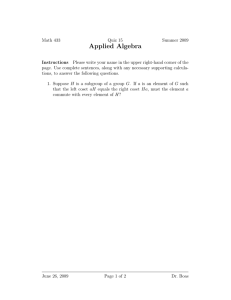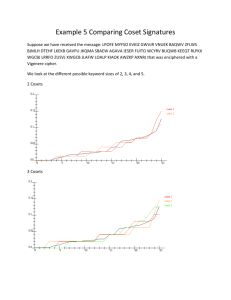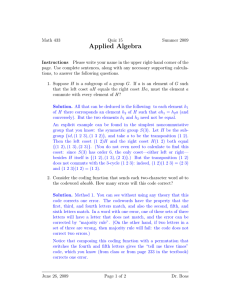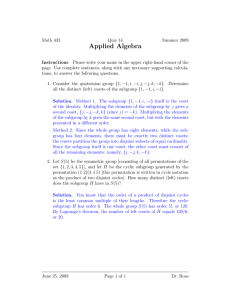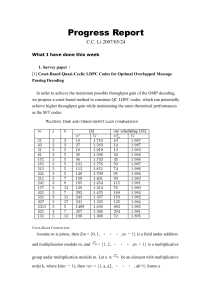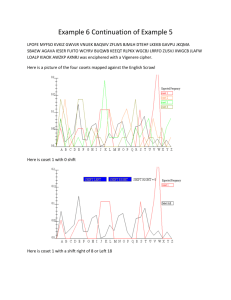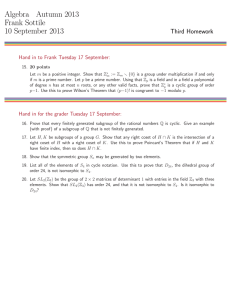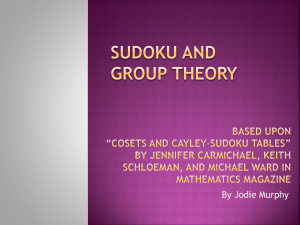Automatic groups, subgroups and cosets Geometry & Topology Monographs Derek F Holt 249
advertisement
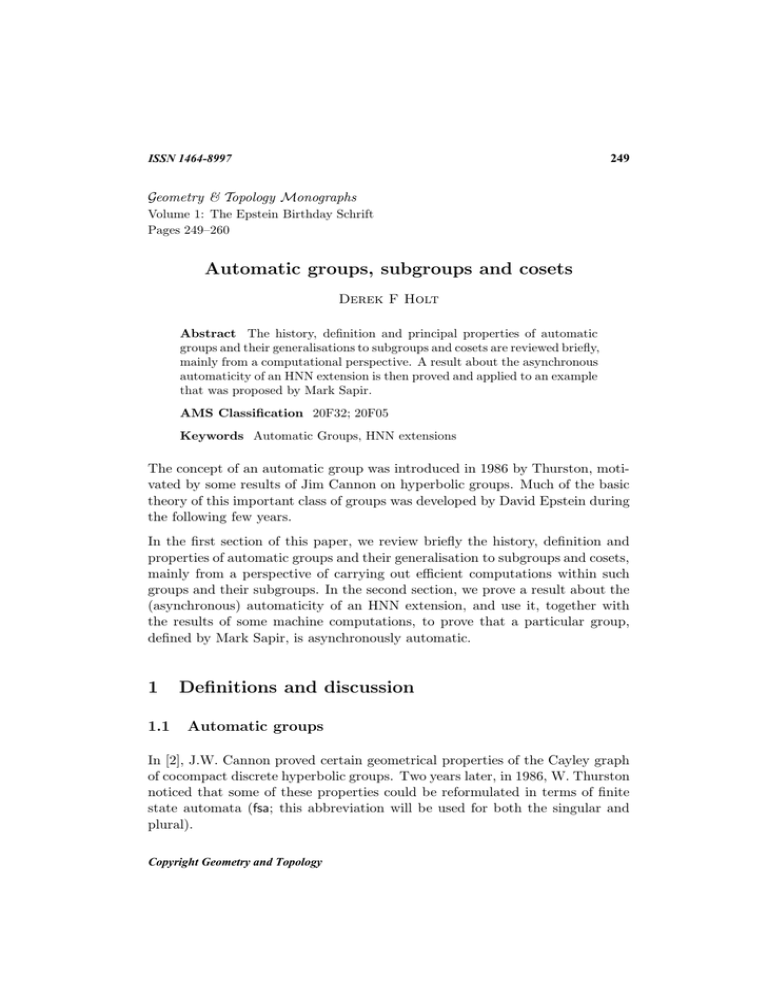
249
ISSN 1464-8997
Geometry & Topology Monographs
Volume 1: The Epstein Birthday Schrift
Pages 249–260
Automatic groups, subgroups and cosets
Derek F Holt
Abstract The history, definition and principal properties of automatic
groups and their generalisations to subgroups and cosets are reviewed briefly,
mainly from a computational perspective. A result about the asynchronous
automaticity of an HNN extension is then proved and applied to an example
that was proposed by Mark Sapir.
AMS Classification 20F32; 20F05
Keywords Automatic Groups, HNN extensions
The concept of an automatic group was introduced in 1986 by Thurston, motivated by some results of Jim Cannon on hyperbolic groups. Much of the basic
theory of this important class of groups was developed by David Epstein during
the following few years.
In the first section of this paper, we review briefly the history, definition and
properties of automatic groups and their generalisation to subgroups and cosets,
mainly from a perspective of carrying out efficient computations within such
groups and their subgroups. In the second section, we prove a result about the
(asynchronous) automaticity of an HNN extension, and use it, together with
the results of some machine computations, to prove that a particular group,
defined by Mark Sapir, is asynchronously automatic.
1
1.1
Definitions and discussion
Automatic groups
In [2], J.W. Cannon proved certain geometrical properties of the Cayley graph
of cocompact discrete hyperbolic groups. Two years later, in 1986, W. Thurston
noticed that some of these properties could be reformulated in terms of finite
state automata (fsa; this abbreviation will be used for both the singular and
plural).
Copyright Geometry and Topology
250
Derek F Holt
In particular, the goedesic paths in the Cayley graph that start at the origin
form a regular set or, equivalently, they form the language of an fsa. Furthermore, any pair of such geodesic paths that end at the same or neighbouring
vertices lie within a bounded distance of each other. It can be deduced that
such geodesic pairs also form the language of an fsa. This led Thurston to
formulate the following general definition.
Definition 1.1 Let G be a group with finite generating set X , let A = X ∪
X −1 , and let A0 = A ∪ {$}, where $ 6∈ A. Then G is said to be automatic
(with respect to X ), if there exist fsa W and Ma for each a ∈ A0 , such that
(i) W has input alphabet A, and accepts at least one word in A∗ mapping
onto each element of G.
(ii) Each Ma has input alphabet A0 × A0 , it accepts only padded pairs, and
it accepts the padded pair (w+ , x+ ) for w, x ∈ A∗ if and only if w, x ∈ L(W )
and wa =G x.
Here A∗ as usual denotes the set of words in A. For w ∈ A∗ , w denotes
the element of G onto which w maps; for w, x ∈ A∗ , we also use w =G x to
mean that w, x map onto the same element of G. The extra symbol $ maps
onto the identity element of G. For w, x ∈ A∗ , the associated padded pair
(w+ , x+ ) ∈ (A0 × A0 )∗ is obtained by adjoining symbols $ to the end of the
shorter of w and x to make them have equal length. The language of the fsa
W is denoted by L(W ). For general properties of finite state automata, the
user is referred to any textbook on automata or formal language theory, such
as [10].
In the definition, W is called the word-acceptor and the Ma the multiplier
automata. The complete collection {W, Ma } is known as an automatic structure
for G. Note that the multiplier M$ recognises equality in G between words in
L(W ). From a given automatic structure, we can always use M$ to construct
another one such that W accepts a unique word mapping onto each element
of G; we simply choose the lexicographically least amongst the shortest words
that map onto each element as the ‘normal form’ representative of that element.
We shall call such a W a word-acceptor with uniqueness.
The best general reference for the theory of automatic groups is the multi-author
book [3]. In particular, it turns out that the automaticity of G is independent
of the choice of generating set X . This immediately suggests that the definition
is a sensible one, because it means that automaticity is an algebraic property
of the group, rather than just a geometrical property of its Cayley graph.
Geometry and Topology Monographs, Volume 1 (1998)
Automatic groups, subgroups and cosets
251
All finite groups are easily seen to be automatic; in fact the class of automatic
groups is invariant under finite variations, such as sub- and super-groups of finite
index. It is also closed under direct and free products, and includes, for example,
all word-hyperbolic groups, braid groups, Coxeter groups and Artin groups of
finite and of ‘large’ type. All automatic groups have finite presentations.
Some of the most important and useful applications of this theory only involve
an explicit knowledge of a word acceptor with uniqueness, particularly in the
frequently occurring case when the accepted words are all geodesics in the
Cayley graph. From such a word-acceptor, one can quickly enumerate unique
representatives of all words up to a given length. This can serve as an invaluable
time-saving device in certain computer graphics applications, such as drawing
tessellations of hyperbolic space on which these groups act freely. One can also
use W to compute the growth function for the group (see [5]).
Another important application of automatic structures for groups G is their
use for the efficient (quadratic time) solution of the word problem in G. More
precisely, the multiplier automata can be used to reduce an arbitrary word in
A∗ in quadratic time to the G–equivalent word in L(W ).
With these applications in mind, a collection of programs was written at Warwick in the late 1980’s for computing automatic structures. These programs
take a finite presentation of the group G as input. Currently, they only work
for so-called shortlex structures, which are those in which L(W ) consists of the
lexicographically least amongst the shortest words that map onto each group
element. (So W depends upon the order of A as well as on A itself.) Many, but
not all, of the known classes of automatic groups are known to possess shortlex
structures. The programs are described in some detail in [4] and [8], and in a
much more general setting in [3]. The latest version is part of a package called
kbmag and is available by anonymous ftp from ftp.maths.warwick.ac.uk in
the directory people/dfh/kbmag2.
From an algorithmic point of view, there is a close connection between automatic groups and rewriting systems for groups, and the programs used make
use of the Knuth–Bendix completion process in groups. However, typically,
this process alone would not terminate and in fact automatic groups normally
have infinite regular rather than finite complete rewriting systems. When the
automatic structure is successfully computed it is, in some sense, enabling this
infinite regular system to be used to solve the word problem in a manner that
is typically at least as efficient as could be done with a finite rewriting system.
The idea of trying to use infinite regular rewriting systems for this purpose was
first proposed by Gilman in [7].
Geometry and Topology Monographs, Volume 1 (1998)
252
Derek F Holt
Given a word-acceptor automaton for a group, it turns out that the existence
and properties of the multiplier automata are equivalent to the so-called (synchronous) fellow-traveller property, which was one of the geometrical properties
of hyperbolic groups observed originally by J. W. Cannon, and is defined as follows.
For a word w ∈ A∗ we denote the length of w by l(w) and, for g ∈ G, l(g)
(or more precisely lA (g)) denotes the length of the shortest word w ∈ A∗ with
w = g . For t ≥ 0, w(t) denotes the prefix of w of length t when t ≤ l(w), and
w(t) = w for t ≥ l(w). The fellow-traveller property asserts that there exists
a constant k such that, for all w, x ∈ L(W ) and a ∈ A such that wa =G x,
−1
and all t ≥ 0, we have lA (w(t) x(t)) ≤ k . In other words, two travellers
proceeding at the same speed along the words w and x from the base point
in the Cayley graph of G would always remain a bounded distance away from
each other.
The fellow-traveller property enables the multiplier automata Ma to be defined
in a uniform manner (see Definition 2.3.3 of [3]). Their state set is the set of
triples (s1 , s2 , g), where s1 , s2 are states of W , and g ∈ G with l(g) ≤ k . The
start state is (s0 , s0 , 1), where s0 is the start state of W . For (a1 , a2 ) ∈ A × A,
there is a transition from (s1 , s2 , g) to (t1 , t2 , h) with label (a1 , a2 ) if and only
if there are transitions s1 → t1 and s2 → t2 in W with labels a1 and a2 ,
respectively, and if a−1
1 ga2 =G h. The state (s1 , s2 , g) is a success state of Ma
if and only if s1 and s2 are success states of W , and g =G a. Thus the Ma
differ only in their accept states. (We have omitted a technicality from this
definition. To deal with the padding symbol, we have to add an extra state
to W which is reached when W is in an accept state and the padding symbol
is read.) It is clear that the Ma behave precisely according to Condition (ii)
of Definition 1.1. This method is used to construct the Ma in the programs
mentioned above.
Note also that it follows from the fellow-traveller property that if g is any fixed
element of G and w, x ∈ L(W ) with wg =G x, then w and x fellow-travel with
constant at most klA (g).
Finally, we must mention the weaker concept of an asynchronously automatic
group, because it will arise in the next section. The definition is the same as
before, except that the multiplier automata are allowed to read their two input
strings at different rates. More precisely, rather than reading one symbol from
each of the two input words at each transition, they read a symbol from one
of the two words only, where the choice of which word to read is a function
of the state of Ma . Of course, when the end of one of the words is reached,
Geometry and Topology Monographs, Volume 1 (1998)
Automatic groups, subgroups and cosets
253
the other word must be selected. See Chapter 7 of [3] for the formal definition.
Again there is a corresponding fellow-traveller property, in which the imaginary
travellers are allowed to move at different speeds. See [3] or Section 7, Part II
of [1] for details.
The word problem is still solvable for asynchronously automatic groups, but it
is unknown whether this can be done in polynomial time. There are examples
known, such as the Baumslag–Solitar groups hx, y | y −1 xp y = xq i with p 6= q ,
which are asynchronously automatic but not automatic.
There is a more detailed treatment, with references to the literature, of the
synchronous and asynchronous fellow-traveller properties in groups in the article [16] in these proceedings.
1.2
Subgroups
Let L = L(W ) be the language of the word-acceptor in an automatic structure
of a group G. A subgroup H of G is called L–rational if L ∩ H is a regular
language (ie the language of an fsa). Such subgroups were studied in [6], where
it is proved that L–rational is equivalent to L–quasiconvex. This means that
any prefix of a word in L∩ H lies within a bounded distance of H in the Cayley
graph of G. Such subgroups are always finitely generated.
An algorithm for constructing an fsa WH with language L ∩ H , which takes as
input an automatic structure for G and a set of generators for an L–rational
subgroup H of G, is described in [12]. A practical and efficient version is
described in [11], and an implementation is available in kbmag.
The fsa WH can be used together with the automatic structure to determine
whether a given word in A∗ lies in H ; that is, to solve the generalised word
problem for H in G. First use the the multiplier automata to reduce the word
to one in L, and then use WH to test whether it lies in H . Given WH and
WK for two subgroups H and K of G, it is easy to intersect their languages to
obtain a fsa WH∩K for their intersection, which can then be used to construct
a finite generating set for H ∩ K .
1.3
Cosets
It is possible to generalise the concept of an automatic group from a notion
about the elements of the group to one about the cosets of a given subgroup H
of G. This has been carried out by two doctoral students of the author (see [15]
and [11]). The definition is as follows.
Geometry and Topology Monographs, Volume 1 (1998)
254
Derek F Holt
Definition 1.2 Let G be a group with finite generating set X , let A = X ∪
X −1 , A0 = A ∪ {$}, and let H be a subgroup of G. Then G is said to be coset
automatic with respect to H , if there exist fsa W , and Ma for each a ∈ A0 ,
such that:
(i) W has input alphabet A, and accepts at least one word in each right coset
of H in G;
(ii) Each Ma has input alphabet A0 × A0 , it accepts only padded pairs, and
it accepts the padded pair (w+ , x+ ) for w, x ∈ A∗ if and only if w, x ∈ L(W )
and Hwa = H x̄.
Here W is called the coset word-acceptor and the Ma the coset multiplier automata. The complete collection {W, Ma } is known as an automatic coset
system for the pair (G, H). Again the existence of such a system turns out to
be independent of the generating set X of G, and we can, if we wish, always
find a new system in which W accepts a unique word in each right coset.
It is proved in [15] that if L is the language of the shortlex automatic structure of
a word-hyperbolic group G (or even the set of all geodesics in the Cayley graph
of G), and if the subgroup H is L–quasiconvex, then G is coset automatic
with respect to H . In [11] the converse is proved for word-hyperbolic groups,
although we shall see from the example in the next section that the converse
does not hold in general.
An interesting application to the drawing of limit sets of Kleinian groups is
described in [14]. As in the graphical applications of ordinary automatic structures, this involves only the use of W to enumerate unique shortest words in
each coset.
An algorithm for computing automatic coset systems in the shortlex case was
first described in [15], and was implemented by him as a standalone program.
It has the disadvantage that it is not usually possible to prove conclusively
that the system computed is correct. A different approach is described in [11].
This does enable the output to be proved correct, but it requires an additional
hypothesis, to be described below, for it to work at all. It has the further
advantage that it has an optional extension to compute a finite presentation for
the subgroup H of G after the automatic coset system has been found. This
second algorithm, together with the subgroup presentation facility, has been
implemented and is available in kbmag. The theory, implementation details
and performance statistics can also be found in [9].
These algorithms provide an alternative method to that described in the previous subsection for solving the generalised word problem for H in G. The
Geometry and Topology Monographs, Volume 1 (1998)
Automatic groups, subgroups and cosets
255
given word in w ∈ A∗ is reduced (in quadratic time, using the coset multiplier
automata) to the unique word w0 in the language of the coset word-acceptor for
which Hw = Hw0 . Then w ∈ H if and only if w0 is the empty word. The two
methods of solving the generalised word problem are to some extent complementary to each other, since there can exist L–quasiconvex subgroups that are
not coset automatic and vice versa, although the two concepts are equivalent
in word-hyperbolic groups.
The additional hypothesis required for the algorithm developed by Hurt is the
following generalisation of the fellow-traveller condition. Let {W, Ma } be the
shortlex automatic coset system for (G, H) that we are trying to compute.
Then, if (w+ , x+ ) ∈ L(Ma ) for some a ∈ A, there exists h ∈ H such that
wa =G hx. The hypothesis is that there exists a constant k ≥ 0 such that
−1
for all such w, x, a and h, and all t ≥ 0, we have lA (w(t) hx(t)) ≤ k . In
particular, taking t = 0, we get lA (h) ≤ k , and so in all such equations, only a
finite number of elements h occur.
One step in the algorithm is to define the states of the Ma as triples (s1 , s2 , g),
as in the automatic group case, but now the initial states are (s0 , s0 , h), where
s0 is the initial state of W , and h is one of the elements of H occurring in the
above equations. So the Ma are in fact constructed initially as non-deterministic
automata with multiple initial states,
If the hypothesis holds, then we shall say that G is strongly coset automatic with
respect to H , and call {W, Ma } a strong automatic coset system for (G, H). It is
proved in [11] that word-hyperbolic groups are always strongly coset automatic
with respect to their quasiconvex subgroups. It is easy to construct examples in
which the hypothesis does not hold, by choosing H to be normal in G, in which
case G coset automatic with respect to H is equivalent to G/H automatic, but
we do not know of any example in which CoreG (H) = 1.
2
HNN extensions and an example
For the application to be described in this section, we need to strengthen the
hypothesis defined at the end of the preceding section for strong automatic
coset systems.
Definition 2.1 Let {W, Ma } be a strong automatic coset system for (G, H)
with respect to the generating set X of G. Let Y be a finite set of generators
of H , and let B = Y ∪ Y −1 . Then Y is said to be efficient with respect to
Geometry and Topology Monographs, Volume 1 (1998)
256
Derek F Holt
{W, Ma } if, for any w, x ∈ L(W ) and any b ∈ B, h ∈ H such that wb =G hx,
we have either h = 1 or h ∈ B .
We are not currently aware of any particular situations under which an efficient
generating set could be shown to exist; it would be interesting to investigate
this question. In specific examples of automatic coset systems that we have
calculated with the programs, it is often possible to observe directly from the
calculation that a particular Y is efficient. The concept is useful to us here,
because it enables us to prove the following result about HNN extensions, which
can then be applied to a specific example. Note that a rather different condition under which an HNN extension of an automatic group is asynchronously
automatic has been proved by Shapiro in [17], and results of a similar nature
for amalgamated free products are proved in [1].
Theorem 2.2 Let {W, Ma } be a strong automatic coset system for (G, H),
let G = hX | Ri be a finite presentation of G, and suppose that H has the
efficient generating set Y . Suppose also that H is automatic, and let α be an
automorphism of H such that α(Y ) = Y .
Then the HNN extension
K = hX, z | R, z −1 yz = α(y) (y ∈ Y )i
is asynchronously automatic.
Proof Let T be a right transversal for H in G. Then by the normal form
theorem for HNN extensions (see, for example, Theorem 2.1 (II), page 182
of [13]), each element of g ∈ K has a unique expression of the form
k = ht1 z n1 t2 z n2 . . . tr z nr ,
where h ∈ H , ti ∈ T , ni ∈ ZZ , ti 6∈ H for i > 1 and ni 6= 0 for i < r.
We use this normal form in the natural manner to construct a regular language
LK for K on the alphabet A ∪ B ∪ {z ±1 } where, as before, A = X ∪ X −1
and B = Y ∪ Y −1 . We are assuming that H is automatic, so we can use the
language LH of the word-acceptor from an associated automatic structure with
alphabet B to obtain a word wh ∈ LH for the element h ∈ H in the normal
form. For T we choose the image in G of L(W ), and to represent ti , we choose
the unique word wi ∈ L(W ) with wi = ti . This clearly yields a regular language
LK mapping bijectively onto K .
We now have to show how to construct the asynchronous multiplier automata
Mc for c ∈ A ∪ B ∪ {z ±1 }. Since this is fairly routine, we describe the construction in outline only. Suppose that u, v ∈ LK and uc =K v , and let the
Geometry and Topology Monographs, Volume 1 (1998)
Automatic groups, subgroups and cosets
257
HNN normal form of k = u be ht1 z n1 t2 z n2 . . . tr z nr , as above. If c = z or
z −1 , then the HNN normal form for kc in K is just ht1 z n1 . . . tr z nr ±1 , and it
is easy to construct Mc . So suppose c ∈ A ∪ B . We shall suppose that nr 6= 0
and omit the details of the case nr = 0, which are similar. There exist words
c1 ∈ B ∗ and c2 ∈ L(W ) such that c =G c1 c2 . Let lB (c1 ) = k . Then, from the
assumptions that the generating set Y of H is efficient and that α(Y ) = Y , it
follows that the HNN normal form in K for kc is
kc = h0 t01 z n1 t02 z n2 . . . t0r z nr c2 ,
where there are elements xi , yi ∈ H (1 ≤ i ≤ r), all having B –length at most
k , such that z nr c1 = yr z nr , ti yi = xi t0i for 1 ≤ i ≤ r, z ni xi+1 = yi z ni for
1 ≤ i < r, and hx1 = h0 . Thus we have u = wh w1 z n1 . . . wr z nr and v =
wh0 w10 z n1 . . . wr0 z nr c2 , where wh , wh0 ∈ LH map onto h, h0 ∈ H , and wi , wi0 ∈
L(W ) map onto ti , t0i ∈ T for 1 ≤ i ≤ r.
The multiplier Mc proceeds by reading the words wh and wh0 in parallel at
the same rate, then the z n1 together, then t1 and t01 together, and so on. If
either of wh or wh0 is longer than the other, then it will wait at the end of the
shorter one until the longer word has been read, and similarly for ti and t0i .
(This explains why Mc needs to be asynchronous. Although |l(wh ) − l(wh0 )|
and |l(ti ) − l(t0i )| are all bounded, there is no bound on r, and so one of the two
tapes of the input of Mc may conceivably get indefinitely ahead of the other;
indeed, we have verified that this really can happen in the example below.)
Of course, if either of the two words input to Mc is not in LK , or if they do not
both have the same pattern with respect to the occurrences of z , then they are
rejected. Otherwise, if after t transitions, Mc has read φ(t) symbols from u
−1
and ψ(t) from v , then the element g(t) = u(φ(t)) v(ψ(t)) of K is remembered
as a function of the state of Mc . As in the synchronous case, it is sufficient to
show that l(g(t)) is bounded.
There are four essentially different situations that occur as the words u, v are
read.
(i) u(φ(t)) and v(ψ(t)) are prefixes of wh and h0 , where |φ(t) − ψ(t)| is
bounded. Then the the boundedness of l(g(t)) from the automaticity of
H , and the fact that hx1 = h0 with l(x1 ) ≤ k .
(ii) u(φ(t)) = wh w1 z n1 . . . wi (s1 ) for some i and some prefix wi (s1 ) of wi , and
v(ψ(t)) = wh0 w10 z n1 . . . wi0 (s2 ), where |s1 − s2 | is bounded. Then g(t) =
−1
wi (s1 ) xi wi0 (s2 ), and its boundedness follows from the assumptions that
lB (xi ) ≤ k and that {W, Ma } is a strong automatic coset system for
(G, H).
Geometry and Topology Monographs, Volume 1 (1998)
258
Derek F Holt
(iii) u(φ(t)) = wh w1 z n1 . . . wi z m1 for some i and some m1 ≤ ni , and v(ψ(t)) =
wh0 w10 z n1 . . . wi0 z m2 , where |m1 − m2 | ≤ 1. Then g(t)z −m1 yi z m2 , and its
boundedness follows from lB (yi ) ≤ k and the assumption that α(Y ) = Y .
(iv) φ(t) > l(u) and ψ(t) ≥ l(v) − l(c2 ). Then l(g(t)) ≤ l(c2 ) which is clearly
bounded.
This completes the proof of the theorem.
As an application, we shall use this theorem together with the results of some
machine computations that were done with kbmag, to prove that the group
defined by the presentation
h a, b, r, t, x, z |
xaxa = t, bxbx = t, bbtaa = t, a−1 br = ra−1 b, zt = tz, btaz = zbta i
is asynchronously automatic.
This group, which we shall denote by K , was originally proposed by Mark Sapir
as a possible building block in his attempts to construct groups with given Dehn
functions. However, he later found a different approach to his problem, and so
the example is no longer relevant from that viewpoint. He had hoped that it
could be proven automatic, but the methods we have been discussing in this
paper only appear to be sufficient to prove it asynchronously automatic.
The computer programs could make no progress with the presentation as given
above, but matters improved after manipulating it a little. Eliminating t =
bxbx, we get
h a, b, r, x, z | xaxa = bxbx, bbxbxaa = xbx,
a−1 br = ra−1 b, zbxbx = bxbxz, bbxbxaz = zbbxbxa i.
Now, putting u = xa and v = bx, and eliminating a = x−1 u = v −1 bu and
x = b−1 v , we get
h u, v, b, r, z | u2 = v 2 , bvbuv −1 bu = b−1 v 2 ,
u−1 b−1 vbr = ru−1 b−1 vb, zv 2 = v 2 z, bvbuz = zbvbu i.
Finally, using u2 = v 2 to simplify the second relation , we get
h u, v, b, r, z | u2 = v 2 , bvbu = b−1 ub−1 v,
u−1 b−1 vbr = ru−1 b−1 vb, zu2 = u2 z, zbvbu = bvbuz i,
This is now visibly an HNN extension of the group
G = h u, v, b, r | u2 = v 2 , bvbu = b−1 ub−1 v, u−1 b−1 vbr = ru−1 b−1 vb i.
Geometry and Topology Monographs, Volume 1 (1998)
Automatic groups, subgroups and cosets
259
with respect to the subgroup H = h u2 , bvbu i, where H is centralised by the
new generator z . (In fact G is itself an HNN extension with extra generator r,
but we shall not make use of that fact.)
Running the automatic coset system program from kbmag on the subgroup H
of G verifies that G is strongly coset automatic with respect to H . (The coset
word acceptor has 302 states, and the coset multiplers about 1400 states.) The
presentation of H computed by the program proves that H is free of rank 2,
and so it is certainly automatic. The programs can also be used to verify that
the set Y = {u2 , bvbu−1 } is an efficient generating set for H . (Briefly, this
is done by constructing the multiple initial state multiplier automata for the
elements u2 and bvbu−1 . The elements of H corresponding to the initial states
of these automata can then be inspected from the output, and it turns out that
these are just the identity and elements of B = Y ∪ Y −1 .) We can now deduce
from the theorem that Sapir’s group K is asynchronously automatic.
As a final remark about this example, it turns out (again using calculations
carried out by kbmag) that the subgroup H is not L–quasiconvex, where L
is the language of the word-acceptor of the shortlex automatic structure of G.
The element (bub−1 v −1 )n (b−1 vbu−1 )n of L lies in H for all n ≥ 0, but the
coset representative of (bub−1 v −1 )n in the language of the coset word acceptor
is b2n .
References
[1] G Baumslag, S M Gersten, M Shapiro, H Short, Automatic groups and
amalgams, J. of Pure and Applied Algebra 76 (1991) 229–316
[2] J W Cannon, The combinatorial structure of cocompact discrete hyperbolic
groups, Geom. Dedicata 16 (1984) 123–148
[3] David B A Epstein, J W Cannon, D F Holt, S Levy, M S Patterson, W
Thurston, Word Processing in Groups, Jones and Bartlett (1992)
[4] D B A Epstein, D F Holt, S E Rees, The use of Knuth–Bendix methods to
solve the word problem in automatic groups, J. Symbolic Computation 12 (1991)
397–414
[5] D B A Epstein, A R Fletcher, U Zwick, Growth functions and automatic
groups, Experimental Mathematics 5 (1996) 297–315
[6] S M Gersten, H B Short, Rational Subgroups Of Biautomatic Groups, Annals
of Math. 134 (1991) 125–158
[7] R H Gilman, ‘Presentations of groups and monoids, J. Algebra 57 (1979) 544–
554
Geometry and Topology Monographs, Volume 1 (1998)
260
Derek F Holt
[8] Derek F Holt, The Warwick automatic groups software, from: “Geometrical
and Computational Perspectives on Infinite Groups”, Gilbert Baumslag et al
(editors), DIMACS Series in Discrete Mathematics and Theoretical Computer
Science 25 (1995) 69–82
[9] Derek F Holt, Darren F Hurt, Computing automatic coset systems and
subgroup presentations, submitted to J. Symbolic Computation
[10] John E Hopcroft, Jeffrey D Ullman, Introduction to automata theory, languages and computation, Addison–Wesley (1979)
[11] Darren F Hurt, The Use of Knuth–Bendix Methods and Automatic Coset
Systems for Solving the Generalized Word Problem and Finding Subgroup Presentations, PhD Thesis, University of Warwick (1996)
[12] Ilya Kapovich, Detecting quasiconvexity: algorithmic aspects, from: “Geometric and Computational Perspectives on Infinite Groups”, Gilbert Baumslag et al
(editors), DIMACS Series in Discrete Mathematics and Theoretical Computer
Science 25 (1995) 91–99
[13] R C Lyndon, P E Shupp, Combinatorial Group Theory, Springer–Verlag,
Berlin–Heidelberg–New York (1977)
[14] G McShane, J Parker, I Redfern, Drawing Limit Sets of Kleinian Groups
Using Finite State Automata, Experimental Mathematics 3 (1994) 153–172
[15] I D Redfern, Automatic Coset Systems, PhD Thesis, University of Warwick
(1993)
[16] Sarah Rees, Hairdressing in groups: a survey of combings and formal languages, these proceedings
[17] M Shapiro, Graph products of automatic groups, unpublished
Mathematics Institute, University of Warwick
Coventry, CV4 7AL, UK.
Email: dfh@maths.warwick.ac.uk
Received: 26 August 1997
Geometry and Topology Monographs, Volume 1 (1998)
